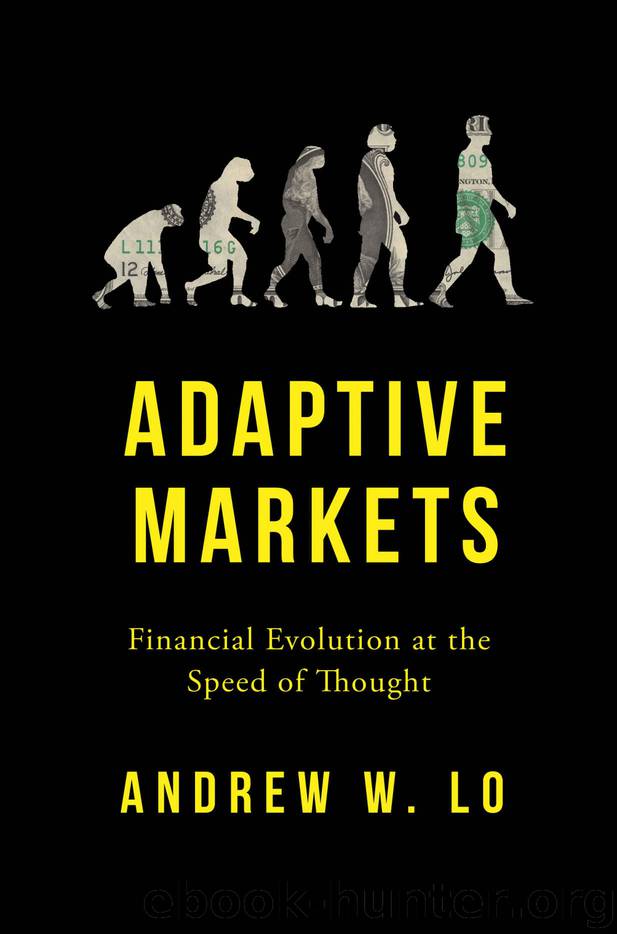Adaptive Markets: Financial Evolution at the Speed of Thought by Andrew W. Lo

Author:Andrew W. Lo
Language: eng
Format: mobi
Publisher: Princeton University Press
Published: 2017-04-23T16:00:00+00:00
THE EVOLUTION OF THE RANDOM WALK
We’ve come a long way from the world of academic finance of 1986, when Craig MacKinlay and I were savaged by our discussant at the NBER’s annual meeting. While academia congratulated itself on its belief in efficient markets, the very people engaged in market practice—Shaw, Simons, Soros, and others—were finding ways to profit handsomely from market anomalies, behavioral biases, and other phenomena rejected by the Efficient Markets Hypothesis and predicted by the Adaptive Markets Hypothesis. In the process, however, they were making markets more efficient, ironically ensuring that evidence contradicting the Efficient Markets Hypothesis was much more difficult to detect. There must be very few fields in human history that have had such clandestine competition, with outside “experts” pronouncing judgment based on ideas already tried and found wanting untold cycles of innovation ago.
Like Darwin’s theory of evolution, the Adaptive Markets Hypothesis is a predictive theory. For the mathematically trained economist, it’s sometimes difficult to think in evolutionary or ecological terms, but sooner or later, this way of thinking will be domesticated (another biological metaphor), and will become another standard tool for economists to use, just as molecular biologists use it today. As a halfway house, we can think of market phenomena in terms of biologically appropriate analogies. Instead of hedge funds with similar strategies pursuing the same “juice,” to borrow Shaw’s term, we can think of an increasing number of predators pursuing the same prey. What happens to the predators when the prey dwindles and disappears?
A current example of evolutionary market dynamics is the waxing and waning of high-frequency trading.36 The evolutionary logic is easy to understand. Investors want their orders executed as quickly as possible so as to profit from their insights, real or imaginary, before the price moves against them. This requires financial intermediaries to maintain a continuous presence in a market to place and consummate those orders. Not very long ago, human market makers and specialists held this role. But faster technology and changes in the regulatory framework let automated trading programs beat specialist desks at their own game, in time periods originally measured in seconds, then in thousandths of a second, and today in billionths of a second.
At first, these high-frequency traders made windfall profits, since human specialists were sluggish and inefficient in comparison. However, there ultimately came a point when high-frequency traders were mainly competing with each other. To succeed in this financial arms race, high-frequency trading firms had to invest in faster and more expensive hardware. At the same time, however, these firms were scouring the market for any trace of “juice” that might be left. In a very short amount of time, high-frequency trading was pushing against its natural evolutionary limits. It had unexpectedly become a mature industry, with low margins on trades and low overall profits. It had also become highly adapted and extremely sensitive to changes in the regulatory environment, for instance, to a Tobin or transactions tax, and even to the physical environment and the
Download
This site does not store any files on its server. We only index and link to content provided by other sites. Please contact the content providers to delete copyright contents if any and email us, we'll remove relevant links or contents immediately.
International Integration of the Brazilian Economy by Elias C. Grivoyannis(74666)
The Radium Girls by Kate Moore(11619)
Turbulence by E. J. Noyes(7700)
Nudge - Improving Decisions about Health, Wealth, and Happiness by Thaler Sunstein(7242)
The Black Swan by Nassim Nicholas Taleb(6762)
Rich Dad Poor Dad by Robert T. Kiyosaki(6174)
Pioneering Portfolio Management by David F. Swensen(6078)
Man-made Catastrophes and Risk Information Concealment by Dmitry Chernov & Didier Sornette(5646)
Zero to One by Peter Thiel(5488)
Secrecy World by Jake Bernstein(4388)
Millionaire: The Philanderer, Gambler, and Duelist Who Invented Modern Finance by Janet Gleeson(4093)
The Age of Surveillance Capitalism by Shoshana Zuboff(3983)
Skin in the Game by Nassim Nicholas Taleb(3965)
The Money Culture by Michael Lewis(3846)
Bullshit Jobs by David Graeber(3828)
Skin in the Game: Hidden Asymmetries in Daily Life by Nassim Nicholas Taleb(3720)
The Dhandho Investor by Mohnish Pabrai(3560)
The Wisdom of Finance by Mihir Desai(3523)
Blockchain Basics by Daniel Drescher(3329)
